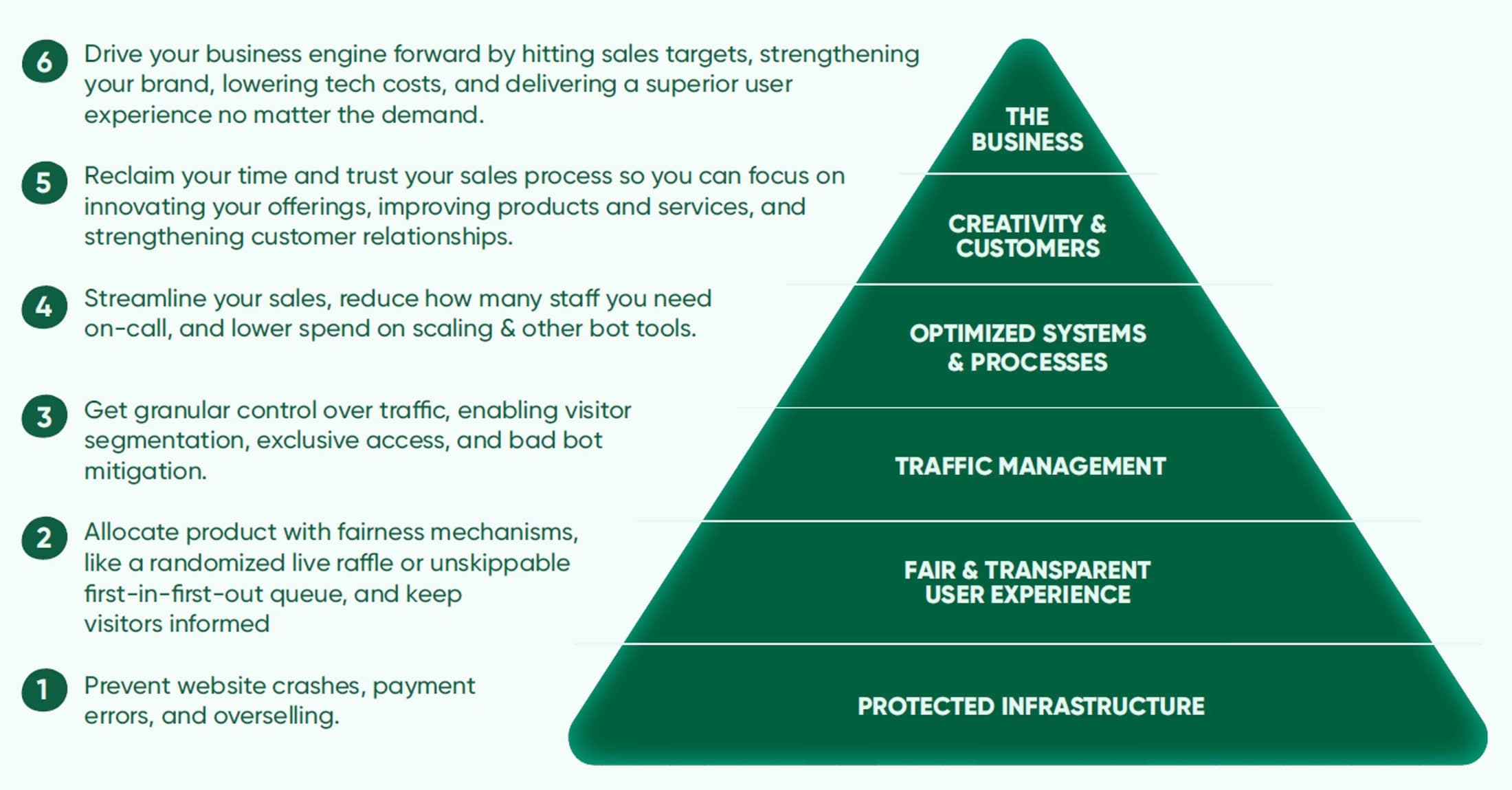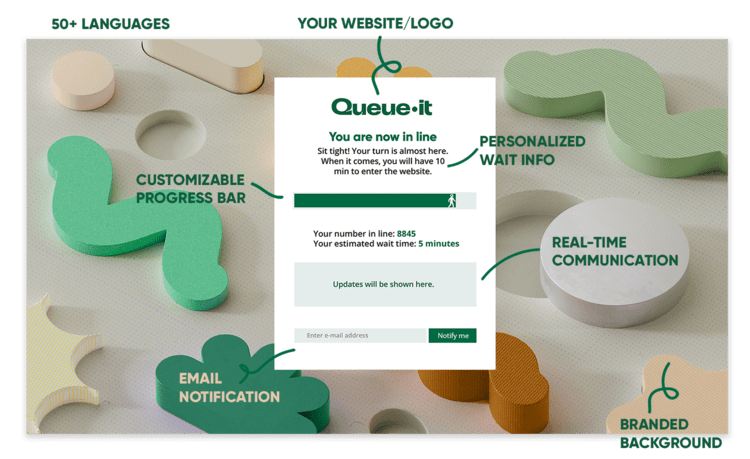Virtual waiting room buyer’s guide: How to choose your online queue system

Virtual waiting rooms are a powerful tool to control your online traffic. But if you’re going to implement one, you want to do it right. Choose wisely by ensuring you've considered these 6 crucial aspects of online queue systems.
If you’re reading this, you’re probably considering taking control of your online traffic with a virtual waiting room. You’re in good company. Virtual waiting rooms are a powerful traffic management solution used by some of the world’s biggest brands.
But choosing a virtual waiting room software provider is a big decision. The flow of online traffic is the river that runs through your website, supporting and sustaining your sales, your brand reputation, and your customer data and interactions. It needs to be controlled with precision, so it doesn’t flood your systems.
Over the years, Queue-it’s How to Choose your Virtual Waiting Room Guide has been among our most popular resources. It’s a comprehensive guide that covers all the critical business and technical considerations you need to inform your decision of how and whether to choose a virtual waiting room.
In this blog, we’ll walk through the virtual waiting room tips in the guide and the key considerations for how to choose an online queue system. For deeper analysis and an interactive checklist, you can download the full guide below.
Table of contents
How can a virtual waiting room help?
How to choose your virtual waiting room
- Consider customer experience
- Factor in fairness
- Compare control & analytics
- Inspect integrations
- Assess accessibility, security & compliance
- Scrutinize support
Discover the virtual waiting room that’s right for you with the full guide

Before we dive into how to choose your virtual waiting room, let’s look quickly at why you’d choose a virtual waiting room.
At its core, a virtual waiting room controls the flow online traffic to your website or app. In high-demand situations, this prevents website crashes, errors like overselling, exorbitant scaling costs, and bots and bad actors.
But taking control of web traffic with a virtual waiting room isn’t just a defensive measure. The best virtual waiting rooms can unlock major benefits across your business. It saves money, frees up resources, and enhances the customer experience. It gives you the confidence to run major online events and delight customers without the risk of failure.

But don’t just take our word for it. Hear what real virtual waiting room users had to say in a recent survey of Queue-it’s customers:
- 84% say their customers’ online experience has improved
- 69% saw fewer customer complaints for sales/registrations
- 85% say their sales are fairer with Queue-it
- 76% say running sales/registrations is less stressful
- 48% average reduction in staff needed on-call during sales/registrations
- 62% say collaboration between tech & business teams improved
- 85% sell through product more efficiently
- 81% say their site performance improved
- 47% say their total revenue increased
- On average customers report a 37% decrease in server scaling costs
- On average customers report a 33% decrease in database scaling costs
RELATED: Queue-it Customer Survey: Real Virtual Waiting Room Results From Real Customers
A virtual waiting room is a high-visibility solution. On your biggest days, when you’re at your busiest, it’s the door your customers pass through to access your site. This makes the customer experience a waiting room provides a paramount consideration.
The first important customer experience consideration is whether your virtual waiting room is designed around the tenets of queue psychology. These include showing progress, setting expectations, ensuring fairness, and allowing customers to occupy their time. Effective use of queue psychology in both physical and virtual queues reduces perceived wait time and makes the experience of waiting easier and more relaxing.
Second, if you want to deliver a seamless experience, your waiting room needs to be highly customizable. Most waiting rooms allow some level of customization, like choosing your own background or adding your logo. But if user experience is a priority, check the solution can go further by letting you customize the URL, the page title, and the favicon so it looks like customers are still on your domain. Other features to look for are mobile app integration and the ability to tailor text to your customers’ local language.

Lastly, if you want to use the waiting room to enhance customer experience, look into whether it can be used to grant early or exclusive access to valued customers. Since your waiting room will already be used to protect your site on its biggest days, see if you can expand its value by gating sales access to reward loyal customers and incentivize member sign-ups. The early or exclusive access tactic is used by 91% of America’s best apparel loyalty programs as a powerful yet cost-effective way to attract and nurture loyalty.
Check your waiting room solution:
- Is designed around the tenets of queue psychology
- Is fully customizable down to domain name & favicon
- Can give exclusive access to valued customers
“Running the sale with Queue-it in place made sure we achieved our goal of delivering an enhanced experience for our loyal members. We gave them the priority access we had promised them as a cornerstone membership benefit.”
TRISTAN WATSON, ENGINEERING MANAGER

When you’re looking to implement a tool that controls access to your site or app, fairness is a crucial consideration. You need to ensure your virtual waiting room solution isn’t vulnerable to bots and can’t be skipped, that you get mechanisms to fairly control timed releases, and that the queue operates in first-in, first-out order—the gold standard for queuing.
To ensure an unskippable queue, you need a solution that can be integrated either server-side, reverse-proxy, or on the edge. The waiting room should also have mechanisms that prevent bots and malicious traffic from bypassing the queue or taking up spots in line.
To operate a first-in, first-out queue (FIFO), a virtual waiting room needs to have a centralized (vs decentralized) list of requests to your website. That way, it can track the order of all traffic, assigning an accurate place in line to your visitors and determining who should be the first ones out.
FIFO isn’t always the best option, though. During scheduled events like product drops, flash sales, or ticket sales, FIFO can artificially move the start time earlier and allow speedy bots to nab the first spots in line. Check your virtual waiting room provider has a way to deal with scheduled events and handle early visitors, such as Queue-it’s pre-queue.

Check your waiting room solution:
- Is unskippable (can be integrated server-side, reverse-proxy, or on the edge)
- Has tools to stop bots & malicious traffic
- Can truly operate as a first-in, first-out system
- Has fair mechanisms for scheduled events & exclusive sales
“Initially, Queue-it was implemented to protect our website infrastructure from spikes in traffic caused by online events. Increasingly it is used to ensure fairness for all our customers when we put relatively scarce tickets on sale, and its robust dependability demonstrates to our customers this fairness.”
CHRISTOPHER J, WEB ARCHITECt
The value of a virtual waiting room lies in the control it gives you. A good solution offers not only control over traffic flow, but also over visitor access, web performance, and customer experience. In our experience, control comes from two key elements: the capacity to control, and the data to inform how you use that control.
Most virtual waiting room buyers don’t need to protect their entire site. It’s often just key bottlenecks in the user journey. To get protection only where you need it and avoid unnecessary queuing of visitors, check the waiting room can be enabled in front of specific landing pages, dynamic requests like “add to cart”, payment gateways, and other common bottlenecks.
Even with a waiting room in place, things don’t always go according to plan. Many companies we work with run thorough tests but find on their big days that customers don’t behave as expected, or the site can’t handle what they thought it could. When this occurs, you need a solution that gives you the flexibility and visibility to act fast. Look for tools that allow you to adjust inflow and outflow in real time, automatically control traffic based on capacity, and pause, resume, or stop the online queue as needed.
To get deeper insight when things go wrong (or right), your waiting room should provide rich data you can analyze both during and after big events. With detailed traffic data, you can extract learnings and optimize your setup for future events. Your waiting room should offer analytics on a variety of topics, such as bots, data center traffic, traffic geography, and individual requests. It should also allow API integration with other analytics tools and export in multiple formats.
RELATED: Traffic Insights: Understand & Act on Your Waiting Room Traffic
Check your waiting room solution:
- Offers flexible site protection, including protection of just key bottlenecks
- Provides real-time data & allows for real-time adjustments to its setup
- Gives detailed, actionable data & analytics on your traffic
“The peace of mind we get from using Queue-it is outstanding ... The virtual waiting room reacts to and controls our traffic instantaneously, and if we need to make any changes, we can easily do it on the spot with the API or the dashboard. The benefit is real, and the ‘sérénite’ is real, too.”
THIBAUD SIMOND, INFRASTRUCTURE MANAGER

If you’re thinking of incorporating a new tool to your tech stack, it’s essential you check it has the right integration and implementation options for your needs. You want your onboarding process to be simple, secure, flexible, and fast.
First, check your virtual waiting room provider has a connector that’s suited to your tech stack. And if you’re running events on a mobile app, you should also ensure the virtual waiting room solution offers SDKs for major native app platforms like iOs, Android, and React Native.
Second, you need to decide how you want to integrate the waiting room and determine if your provider can offer that integration. There are four main methods—client-side, server-side, edge, and reverse proxy—each with their own pros and cons. But in our experience, an edge integration is the simplest and safest to set up.
Here’s the four main integration types and their pros and cons:
|
|
Client-side |
Server-side |
Edge |
Reverse proxy |
|
Quick to integrate |
✅ |
|
✅ |
✅ |
|
Unskippable queue |
|
✅ |
✅ |
✅ |
|
Allows visitor verification |
|
✅ |
✅ |
✅ |
|
Protects the origin from requests |
|
|
✅ |
✅ |
|
Easy to troubleshoot |
✅ |
|
✅ |
✅ |
|
Works on websites, apps & PWAs |
✅ |
✅ |
✅ |
✅ |
|
Doesn’t require a CDN with edge computing |
✅ |
✅ |
|
✅ |
|
Doesn’t expose data to the VWR provider |
✅ |
✅ |
✅ |
|
RELATED: Explore Queue-it’s Connectors
Check your waiting room solution:
- Has the right connector for your tech stack
- Offers different integration options to suit your needs
“I can count on one hand the number of times in my career I've implemented a new technology and it exceeded my expectations. Queue-it is one of those times, both in how easy it is to implement, and in how well it works.”
DENIS GOULET, NEW HAMPSHIRE STATE CIO

Ensuring your virtual waiting room is accessible, secure, and compliant with relevant regulations should be non-negotiable.
If you’re dealing with enough demand to need a waiting room, you’re probably also facing cyber threats and attacks. This means you need to thoroughly scrutinize all new services to ensure they don’t create vulnerabilities. Check your waiting room provider uses encrypted HTTPS protocols, uses Multi-Factor Authentication (MFA) for log-in, and undergoes regular cybersecurity checks like penetration testing and open-source vulnerability scanning.
It's just as critical to protect your customers as it is your company, so you should also ensure no user data is exposed. You can check this by verifying your solution doesn’t expose your payload or session data—which could include things like credit card and personal information. It should also offer an option to protect the user session and prevent unauthorized access to sensitive information by securing cookies.
Beyond these security measures, the waiting room must also be compliant with the regulations and accessibility guidelines of the region you operate in. If you want to be even more confident about user data and security, you can also check the solution’s compliance with other world-leading standards.
Check your waiting room solution:
- Uses encrypted HTTPS protocols & MFA for log-in
- Undergoes regular cybersecurity checks
- Doesn’t expose users’ payload or session data
- Is compliant with your region’s data privacy regulations & accessibility guidelines
RELATED: Explore Queue-it’s Security, Compliance, and Accessibility
“Queue-it allows us to investigate traffic to work out where demand is coming from and whether it’s genuine. And if it isn’t, we can isolate it and put it in what I call IP jail. From a security perspective that’s crucial. It gives us the visibility and flexibility to act fast.”
ELAINE SALVETA, DIGITAL SERVICES MANAGER

Customer support and documentation can make or break your experience with a technology vendor. Support is especially important in the virtual waiting room space, as the solution is needed on your biggest days—when you’re at your most visible and vulnerable.
A good virtual waiting room solution should offer strong support both throughout the onboarding process and on your big days, regardless of subscription tier. Big traffic spikes don’t follow business hours, so you’ll want 24/7/365 support with quick response times.
The best way to get a sense of a vendor’s quality of support is to read their success stories or check review sites like G2 to hear first-hand experiences from the companies they work with.
Check your waiting room solution:
- Provides 24/7/365 support regardless of subscription tier
- Offers help with onboarding & “at-the-elbow” support on your big days
- Has positive testimonials on leading review sites like G2
“In my opinion, Queue-it is one of the best vendors we've ever worked with because they are as dedicated to our brand as we are.”
ALEX WAKIM, DIRECTOR OF OPERATIONS & BUSINESS DEVELOPMENT

Many of the companies we speak to have worked with other virtual waiting room providers in the past. Often, these providers can fulfil a few of their needs, but not all of them. Several virtual waiting room providers offer limited customization, or little support, or don’t provide targeted control over traffic.
To ensure you make the right choice the first time, check your virtual waiting room solution:
- Provides a top-tier customer experience
- Ensures fairness & protects your site & customers from bots
- Gives you granular control & rich insights into traffic
- Offers simple, secure & quick implementation & integration
- Is accessible, secure & compliant with industry standards & regulations
- Will support you however you need, whenever you need it
To get more info on each of these points and an interactive checklist you can use to compare solutions, download the How to Choose your Virtual Waiting Room Guide.
Queue-it is the market-leading developer of virtual waiting room services, providing support to some of the world’s biggest retailers, governments, universities, airlines, banks, and ticketing companies.
Our virtual waiting room and the customers that use it are our core focus. We provide 24/7/365 support from across three global offices and have a 9.7/10 Quality of Support rating on G2 from over 100 reviews. Over the past 10 years, our 1,000+ customers have had over 75 billion visitors pass through our waiting rooms.
When Ticketmaster, The North Face, Zalando, Cathay Pacific, and The London School of Economics need to control their online traffic, they turn to Queue-it.